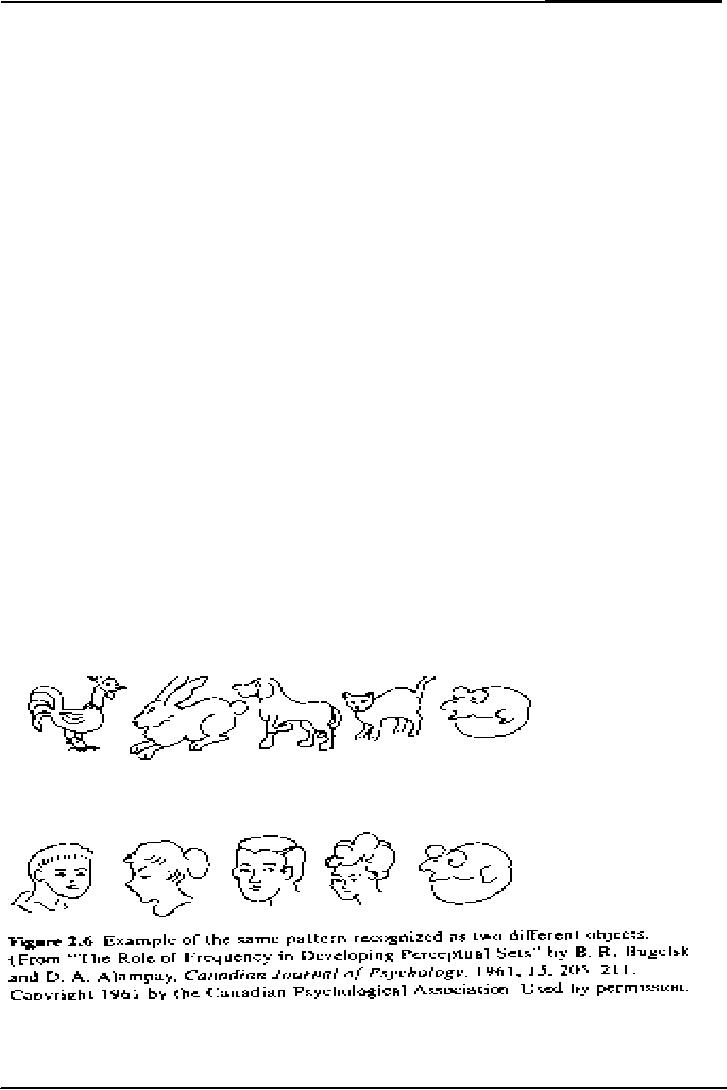 |

Cognitive
Psychology PSY 504
VU
Lesson
20
ATTENTION &
PATTERN RECOGNITION
Attention is
required to combine features to
perceive patterns.
Treisman
& Gelade (1980) performed an
experiment. They had the
subjects try to detect a T
in
an
array of 30 I's and Y's.
They reasoned that subjects
could do this by simply
looking for the
cross-bar
feature of the T that
distinguishes it from all
I's and Y's. Subjects
took about 800
milliseconds
to make this decision.
Triesman and Gelade also
asked subjects to detect T in
an
array
of 30 I's and Z's. In this
condition, they could not
use just the vertical
bar or just the
horizontal
bar of the T; they could
have to look for the
conjunction of these features,
performing
the
feature combination required in
pattern recognition. It took
subjects more than
1200
milliseconds
to make their decision.
Thus, a condition requiring
them to recognize the
conjunction
of features took about 400
milliseconds longer than one
in which perception of a
single
feature was sufficient.
Triesman and Gelade varied
the size of the display
they found that
subjects
were much more affected by
display size in the
condition that required
recognition of the
conjunction
of features. Subjects showed
little difference between
the single feature and
the
conjunction
condition for displays
containing fewer than five
letters. Only with displays
presenting
more
distracters did subjects'
attention become substantially
overload. It might seem
surprising
that
attention is required to detect
patterns of features that
define common letters. We
have
experience
of automatically recognizing letters.
For familiar letters the
deficit in perception of
feature
conjunctions only becomes
apparent with large
displays.
Attention
is not just
orientation.
Context
& Pattern Recognition
Look
at the top line you
see a hen, a rabbit, after
the rabbit there is dog
and cat. After that
there is
an
animal even it is not clear.
In bottom line you can
see a picture of man, woman,
child and girl.
We
perceive the last picture as
a picture of human. Even
this picture is same like
the above
picture.
Because of the context we
perceive things. Same
picture when is included in
animals
picture
we perceive it as animal and
when this is in human
pictures we perceive it as
human.
Top-Down
Processing
63

Cognitive
Psychology PSY 504
VU
The
general context provided by
the words forces the
appropriate interpretation. When
context or
general
world knowledge guides
perception, we refer the
processing as top- down
processing,
because
high-level general knowledge
determines the interpretation of
the low-level
perceptual
units.
THE
CAT
The
middle letter can be seen as
A or H.
Top
Down Processing or contextual
effects. It means surrounding
has effect on our
perception.
Word
Superiority Effect
This
phenomenon can be understood by
the experiment of Reicher
and Wheeler
(1970).they
presented
a brief presentation of either a
letter (D) or a word (WORD).
Immediately afterward
they
were given a pair of
alternatives and instructed to
report which they had
seen. If they had
been
showed D, subjects might be
presented with D or K as alternatives. If
they had been
shown
WORD,
they might be given WORd, or
WORK as alternatives.Subjects showed a
letter alone or
in
a word. Subjects were about
10% better in word
condition. They more
accurately discriminated
between
D and K in the context of
word than as letters alone.
This phenomenon is called
word
superiority
effect (WSE).
Why
WSE?
Rumelhart
& Siple (1974) has
provided one explanation for
Why subjects are more
accurate in
the
word condition. Suppose
subjects are able to
identify the first three
letters as WOR. Now
consider
how many four-letters words
are consistent with a WOR
beginning WORK, WORD,
WORM,
WORN, WORT
Suppose
subjects only detect the
bottom curve in the fourth
letter. However, when the
letter is
presented
alone and subjects detect
the curve, they will
not know whether the
letter was B, D, O,
or
Q, since each of these
letters is consistent with
the curve feature. Thus, in
WOR context
subjects
need only detect one
feature in order to perceive
the fourth letter, but
when the letter is
presented
alone they must identify a
number of features. Their
analysis implies that
Perception is
inferential.
Like curve in D will help in
recognition
64
Table of Contents:
- INTRODUCTION:Historical Background
- THE INFORMATION PROCESSING APPROACH
- COGNITIVE NEUROPSYCHOLOGY:Brains of Dead People, The Neuron
- COGNITIVE NEUROPSYCHOLOGY (CONTINUED):The Eye, The visual pathway
- COGNITIVE PSYCHOLOGY (CONTINUED):Hubel & Wiesel, Sensory Memory
- VISUAL SENSORY MEMORY EXPERIMENTS (CONTINUED):Psychological Time
- ATTENTION:Single-mindedness, In Shadowing Paradigm, Attention and meaning
- ATTENTION (continued):Implications, Treisman’s Model, Norman’s Model
- ATTENTION (continued):Capacity Models, Arousal, Multimode Theory
- ATTENTION:Subsidiary Task, Capacity Theory, Reaction Time & Accuracy, Implications
- RECAP OF LAST LESSONS:AUTOMATICITY, Automatic Processing
- AUTOMATICITY (continued):Experiment, Implications, Task interference
- AUTOMATICITY (continued):Predicting flight performance, Thought suppression
- PATTERN RECOGNITION:Template Matching Models, Human flexibility
- PATTERN RECOGNITION:Implications, Phonemes, Voicing, Place of articulation
- PATTERN RECOGNITION (continued):Adaptation paradigm
- PATTERN RECOGNITION (continued):Gestalt Theory of Perception
- PATTERN RECOGNITION (continued):Queen Elizabeth’s vase, Palmer (1977)
- OBJECT PERCEPTION (continued):Segmentation, Recognition of object
- ATTENTION & PATTERN RECOGNITION:Word Superiority Effect
- PATTERN RECOGNITION (CONTINUED):Neural Networks, Patterns of connections
- PATTERN RECOGNITION (CONTINUED):Effects of Sentence Context
- MEMORY:Short Term Working Memory, Atkinson & Shiffrin Model
- MEMORY:Rate of forgetting, Size of memory set
- Memory:Activation in a network, Magic number 7, Chunking
- Memory:Chunking, Individual differences in chunking
- MEMORY:THE NATURE OF FORGETTING, Release from PI, Central Executive
- Memory:Atkinson & Shiffrin Model, Long Term Memory, Different kinds of LTM
- Memory:Spread of Activation, Associative Priming, Implications, More Priming
- Memory:Interference, The Critical Assumption, Limited capacity
- Memory:Interference, Historical Memories, Recall versus Recognition
- Memory:Are forgotten memories lost forever?
- Memory:Recognition of lost memories, Representation of knowledge
- Memory:Benefits of Categorization, Levels of Categories
- Memory:Prototype, Rosch and Colleagues, Experiments of Stephen Read
- Memory:Schema Theory, A European Solution, Generalization hierarchies
- Memory:Superset Schemas, Part hierarchy, Slots Have More Schemas
- MEMORY:Representation of knowledge (continued), Memory for stories
- Memory:Representation of knowledge, PQ4R Method, Elaboration
- Memory:Study Methods, Analyze Story Structure, Use Multiple Modalities
- Memory:Mental Imagery, More evidence, Kosslyn yet again, Image Comparison
- Mental Imagery:Eidetic Imagery, Eidetic Psychotherapy, Hot and cold imagery
- Language and thought:Productivity & Regularity, Linguistic Intuition
- Cognitive development:Assimilation, Accommodation, Stage Theory
- Cognitive Development:Gender Identity, Learning Mathematics, Sensory Memory